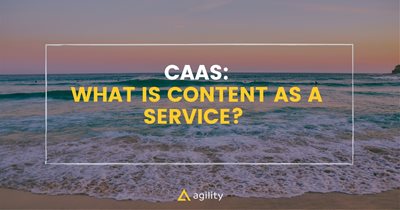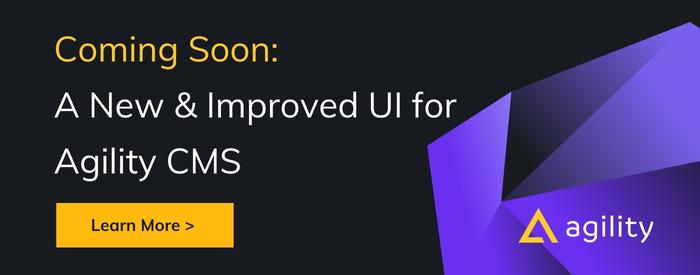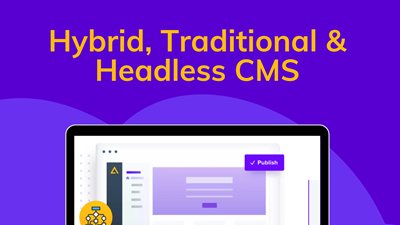What is Content as a Service? (CaaS)
Are you tired of the continual process of posting content, updating it over time, and optimizing it to adapt responsively to each reader’s device? If so, content as a service (CaaS) might be for you.


Read the Updated Blog: What is Content-as-a-Service in 2025-2026?
With companies expanding their marketing assets and increasing the number of websites, microsites, and general web properties they have, content management as a process has grown to be quite complicated. Many get so frustrated with the time-intensive manual workload of content optimization that they throw in the towel altogether.
It’s a sad reality, but it doesn’t need to be this way. This brings us back to CaaS; one of the latest ways to guarantee that your content reaches the right people, in the right form, at the right time.
What is Content as a Service (CaaS)?

Let’s start with an overview of the CaaS content as a service framework and how it differs from the content presentation paradigm you might be familiar with.
What is content as a service? In essence, it’s a new approach to a content presentation that collects all of a company’s content assets in a cloud-based server and intelligently presents it to readers upon request. Content is uploaded to the repository with tags and metadata to help categorize it. When it’s needed, it’s sent out to each reader and displayed in a format that’s optimized to the reader’s device, no matter if it’s a computer, tablet, or smartphone.
A Quick Overview of the CaaS Process
When a company’s copywriter authors an article or piece of content, he/she will upload that article to the CaaS server, adding appropriate tags and metadata to help the platform categorize it in the database. There it sits until it’s ready to be retrieved. The company will then produce a link to the web page and share it on Twitter or Facebook to get the word out. When an interested reader clicks the link, they’re sent to a web page where the content can be read.
(But remember, all content in the CaaS server is stored off-site, meaning that the blog doesn’t really exist on the web page until the request is made. With a traditional CMS, the blog is there at all times.)
When users arrive at the blank web page, the CaaS system automatically detects (via APIs) what type of device the reader is using and how best to optimally format it for the best possible viewing experience.
This is the process for a basic web page, but the beauty of CaaS is that it’s flexible. You can push content to nearly any device or use case that makes sense for your viewers, including mobile apps, smart TV apps, kiosks, and more. The fundamental idea is the same; the CaaS framework routes data to any system for display, suited to each user’s viewing preferences. CaaS makes it easy to create a consistent and simple managed content system across all digital channels.
Compare this to a more traditional content management system (CMS) like WordPress or Ghost. These self-publishing platforms store content on-site, offering a simple way to host content. But the display and personalization options are limited to what the platform can do, and content must be shared manually across web properties. CaaS utilizes a non-traditional approach based on headless architecture – meaning that these platform restrictions are stripped away, freeing up users to present content exactly how they want.
Applications and Examples of Content as a Service

An easy way to look at the benefits of CaaS is by comparing it to its traditional counterparts. Where a traditional CMS is rigid, CaaS is flexible and adaptable. This presents several big advantages for your content presentation goals.
Reusable Content
The centralized nature of CaaS makes it super easy to reuse and repurpose content, eliminating the need to update content manually across each of your websites and applications.
The advantage here is that you’re hosting a single repository for all content
and sending that content to where it’s needed. Any changes you make to the main library will apply to all future requests from the CaaS system.
For example, consider an article that forecasts market trends for web development in 2020. You might write this at the beginning of the year to pique readers’ interest, but as the fiscal year progresses, you’ll have access to new data and financial figures. To maintain readership value of the piece, this content would need to be updated with these new numbers across all channels – no small task under a traditional CMS! Every copy of the blog on every website, publishing platform or application will need to be updated by hand. Who has time for that?
Compare this with CaaS and its centralized content library
. In the CaaS framework, you need to update your blog only once within the content hub
. Once this simple update is done, every future request for the content will pull the fresh copy. It’s a smarter system of content management that’s undoubtedly faster, more efficient, and more financially tenable at scale.
Multi-channel Marketing
One of the biggest benefits of CaaS is how it streamlines your company’s multi-channel marketing goals. It’s no secret that users these days jump from device to device, expecting the same great experience every time.
Under a traditional content presentation system, each piece of content you own would need to be hosted and displayed through a responsive web architecture that allows it to be presented on different devices.
Is this doable? Absolutely. But is it ideal for companies with multiple websites, applications, and mobile experiences to manage? Not at all!.
CaaS does the same job but in a smarter, more scalable way. Rather than managing a responsive layout on the website itself, the tagging and presentation is done off-site. This means that companies can design simple, low-cost websites and applications for their marketing goals as needed and populate them with optimized content at a moment’s notice. Multiple platforms can pull content directly from the CaaS cloud server; no matter how many sites or apps there are, the CAAS provides custom-fitted content everywhere, every time.
Design Flexibility
A key benefit of the headless architecture found in CaaS is design flexibility. Headless CMS architecture separates the backend functionality from the frontend content presentation layer, meaning that web designers won’t have to worry about how the content will fit in a rigid web design layout. In other words, they have complete freedom to design in a way that makes sense for the readers, rather than designing for what the system can accommodate. Particularly for content-heavy brands, this UX optimization can provide big boosts to readability and time spent on-site.
Getting Started With Content as a Service

As cloud-based architecture becomes more affordable, more companies are able to explore the benefits of managed services. Content as a service is no exception. From reusability to multi-channel marketing optimization, there’s plenty of benefits to a CaaS framework – provided that you have the right software to make content management as a service feasible within your organization.
At Agility CMS, we specialize in both headless CMS integration and expert consulting on content architecture for growing brands. There’s no one-size-fits-all type of integration here; every project needs to be adapted to the unique IT infrastructure you have in place. If you’re curious about how a CaaS integration might benefit your marketing goals, contact us and we’ll be happy to walk you through the details.
Keep Reading
If you want to learn more about Headless CMS, make sure you read these articles:






